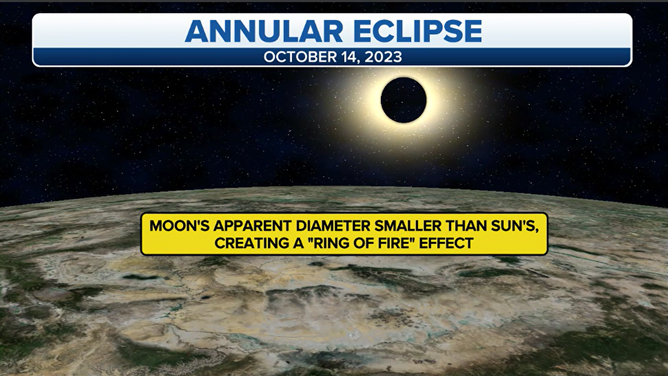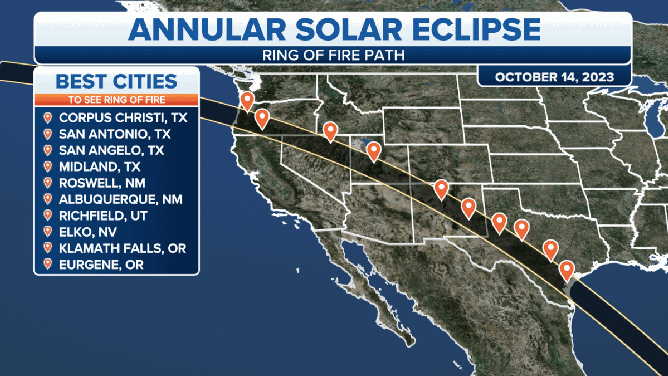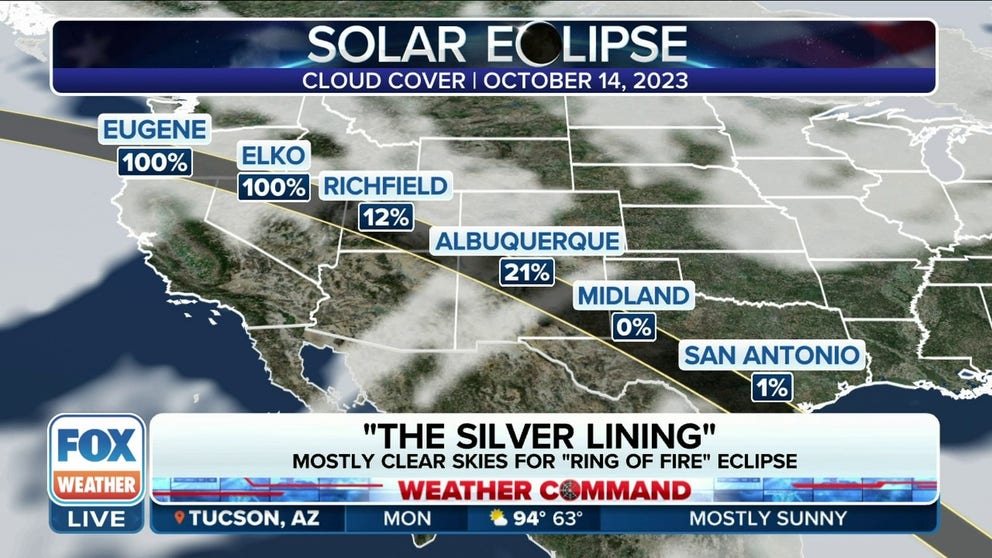Where to see the 'Ring of Fire' in Texas during the October annular solar eclipse
The annular solar eclipse will cut a path from West Texas to the Gulf Coast, offering millions the chance to see the features this eclipse is known for, including the "ring of fire."
Mostly clear sky for 'Ring of Fire' eclipse on Oct. 14
The forecast for the annular solar eclipse includes mostly clear skies for the path of maximum eclipse on Oct. 14. FOX Weather will be in Albuquerque for the eclipse coverage on Saturday.
Nine states are along the path of the maximum eclipse, which stretches from Oregon to Texas. The peak solar eclipse will be visible across the Lone Star State from the Big Bend to the Gulf Coast of Texas.

The path of the Oct. 14 annular eclipse in Texas.
Here's what you need to know about viewing the 2023 annular solar eclipse in Texas.
What is an annular eclipse?

Annular solar eclipse
(FOX Weather)
An annular eclipse is not a total eclipse, as the Moon doesn’t entirely block the Sun’s light – only 90%. An annular eclipse happens when the Moon is at the farthest point in its orbit of Earth. During the maximum eclipse, known as annularity, the light from the Sun peaks out around the Moon, creating the "ring of fire" the annular eclipse is known for.
WHERE TO VIEW THE 'RING OF FIRE' IN OREGON DURING THE OCTOBER ANNULAR SOLAR ECLIPSE
Unlike a total solar eclipse, you will need to wear special eclipse glasses during the entirety of the annular eclipse. Taking the glasses off at any point, even during the maximum eclipse, is unsafe.
Where can I see the 'ring of fire' in Texas?
The annular solar eclipse will cut a path from West Texas to the Gulf Coast, offering millions the chance to see the features this eclipse is known for, including the "ring of fire," the Diamond Ring and Baily's Beads.

File photo: Tourists gather in front of the chapel of the Alamo Mission, known as the "Shrine of Texas Liberty", in downtown San Antonio Texas, on January 23, 2023. (Photo by DANIEL SLIM/AFP via Getty Images)
Those smack dab in the middle of the 125-mile-wide eclipse path will have the longest time to see annularity.
Historic sites in the Lone Star State, including The Alamo Mission in San Antonio, are along the annular solar eclipse path on Oct. 14.
Even those on the outer edges of the eclipse path will have a brief chance to see the "ring of fire."
On the Gulf Coast, the Aransas National Wildlife Refuge and Matagorda Island National Wildlife Refuge are on the northern limits of annularity. They can see the maximum eclipse for just over 1 minute.
When is the solar eclipse in Texas?
In the U.S., the eclipse begins in Oregon at 8:06 a.m. PDT, and the partial eclipse ends in southeastern Texas just after 1:30 p.m. CDT.

Each state from Oregon to Texas with the path of solar eclipse highlighted.
(FOX Weather)
When the eclipse starts and ends, it will vary by only a few minutes across Texas, but a partial eclipse will be visible across the state just after 10:15 a.m. CDT.
Starting where the Texas panhandle and West Texas meet, eclipse viewers in Odessa will be able to see the "ring of fire" at 11:43 a.m. Annularity lasts for just under 5 minutes in West Texas. Maximum eclipse happens at 11:45 a.m. in Midland, also for about 5 minutes.
San Angelo and San Antonio are also along the 125-mile path of the maximum eclipse. Annularity in San Antonio begins at 11:52 a.m. and lasts just over four minutes.
Finally, the "ring of fire" exits Texas on the Gulf Coast and will be visible for about 5 minutes in Corpus Christi beginning at 11:55 a.m. CDT.
What will the weather be like in Texas for the annular eclipse?
As the solar eclipse approaches, the forecast will firm up. In the meantime, the FOX Future Model shows almost no cloud cover over most of Texas for the eclipse.
SOLAR ECLIPSE FORECAST: SOUTHWEST LIKELY TO HAVE BEST VIEWING CONDITIONS FOR OCTOBER 'RING OF FIRE'
In Corpus Christi, the temperature will be warm, with a high in the upper 80s by the afternoon. In West Texas, temperatures will be more moderate, with a high forecast of around 85 degrees.

(FOX Weather)
Stay with FOX Weather as the annular solar eclipse nears for a detailed forecast.
